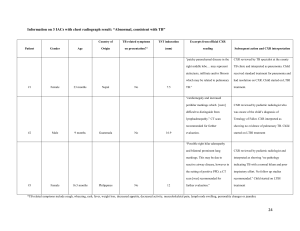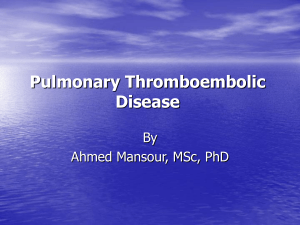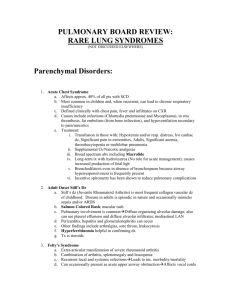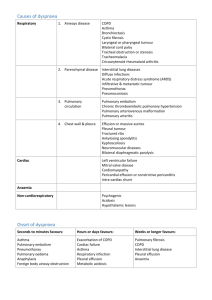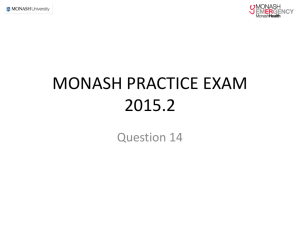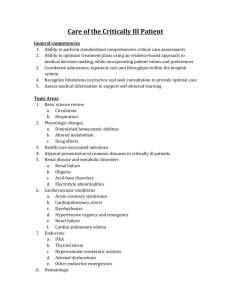Pleural effusion
advertisement
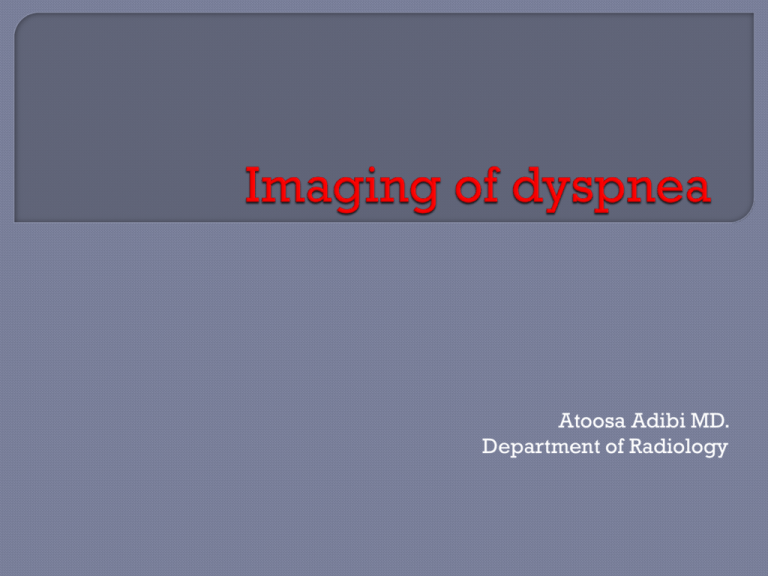
Atoosa Adibi MD. Department of Radiology The most common diagnoses among elderly patients presenting to an ED with a complaint of acute shortness of breath or dyspnoea are: decompensated heart failure pneumonia chronic obstructive pulmonary disease pulmonary embolism asthma A CXR is frequently helpful in evaluating patients with dyspnoea. Characteristic roentgenographic findings occur in patients with congestive heart failure and pneumonia, and pulmonary fibrosis. The chest radiograph may also be abnormal in patients with obstructive pulmonary disease, but the chest film (particularly the bedside chest film) have low sensitivity above all for the detection of airflow obstruction or pulmonary embolism. Very often COPD exacerbation with involvement of large and/or small airways is not associated with radiographic signs. CXR demonstrates abnormal images only in 16% of cases, mainly limited to signs of inflammatory infiltrates or pulmonary congestion . • Chest radiography • Emphysema: obvious bullae, paucity of parenchymal markings, or hyperlucency • Hyperinflation: increased lung volumes, flattening of diaphragm Does not indicate chronicity of changes • Chest CT • Definitive test for establishing the diagnosis of emphysema, but not necessary to make the diagnosis PA CXR in an emphysematous patient. Multiple bronco-pneumonic bilateral outbreaks, confluent in the right region. Left pleural effusion For these reasons CXR is not recommended as a routine exam, but only in cases of suspected pneumonia, or to rule-out other causes of dyspnoea, such as massive pleural effusion, atelectasis, pneumothorax, pulmonary edema. CXR represents the first line imaging exam in a patients presenting to the ED complaining of acute dyspnoea. The possibility of correct diagnosis at CXR is directly proportional to the severity and the duration of pulmonary congestion. The role of CXR is not only the first diagnosis of APE, but also the differentiation between cardiogenic and non-cardiogenic causes , and guiding treatment. the radiologic signs and findings to be studied are: the perfusion pattern and the spatial distribution of oedema, the size of the vascular peduncle the cardiac volume. Moreover, it is highly important the recognition of some specific signs, like lung interstitial oedema, pleural effusion and air bronchogram. Stage 1 Redistribution PCWP 13-18 mmHg-Redistribution of pulmonary vessels -Cardiomegaly -Broad Vascular Pedicle (non acute CHF) Stage 2 Interstitial Edema PCWP18-25 mmHg-Kerley lines -Perbronchial cuffing -Hazy contour of vessels -Subpleural edema Stage 3 Alveolar Edema PCWP > 25 mmHg-Consolidation -Butterfly appearance -Cottonwool appearance -Pleural effusion enlargement of atrial and left ventricles, with redistribution of lung circulation from bases to apex suggestive to pulmonary congestion in a patient with acute decompensated heart failure. Posterior-anterior CXR in a patient with congestive heart failure and interstitial pulmonary edema. Note the large heart shadow, the thickening of the pulmonary perihilar interstitium, the modest pleural effusion and the B Kerley’s lines. cardiogenic alveolar edema: patchy or confluent consolidation shadows, with large pleural effusion. Cardiomegaly is also present. Cardiac ARDS Heart size Enlarged Normal Vascular pedicle Normal or enlarged Normal or reduced Pulmonary blood flow distribution Inverted Balanced Perbronchial cuffs Common Not common Regional distribution lung edema Even Peripheral/patchy Air bronchogram Not common Very common Pleural effusion Very common Not common ARDS in H1N1 virus pneumonia.Supine CXR showing bilateral, predominantly peripheral, asymmetrical patchy consolidation with air bronchograms.Septal lines and pleural effusions, are absent CXR is not sensitive enough to rule out heart failure in the presence of a normal radiologic pattern or specific enough to rule - in the condition in the presence of an abnormal pattern. However, CXR is helpful, to rule-out other conditions that may enter the differential diagnosis Cardiogenic pulmonary edema: incidental finding in HRCT, smooth septal thickening with basal predominance (Kerley B lines), ground-glass opacity with a gravitational and perihilar distribution, (peribronchial cuffing) CXR has a limited role in the diagnostic process of APT, primarily related to the exclusion of other common causes of respiratory failure and chest pain, because it is burdened by a low sensitvity and specificity. Quite often, CXR is completely normal in APT. Instead, spiral angio-CT (SCT) scan has a well defined role and it is the first level radiographic test. SCT has a higher sensitivity (87% vs. 33%) and specificity (95% vs. 59%) over CXR I) Pulmonary infiltrates, due to haemorrhagic or oedematous infiltration of secondary lobules, often multiple and presenting as round foci of alveolar consolidations or irregular jeopardized opacities, without a segmental arrangement, more often located to the right base, sometimes associated with signs of atelectasis or pleural effusion (II) Atelectasis, often sub-segmental, appearing as curved lines reaching the pleura, secondary to alveolar collapse (line of Fleishner), caused by bronchial obstruction due to mucosa congestion, or alveolar collapse secondary to surfactant reduction, or hypoventilation due to reduced diaphragmatic excursion. Pulmonary thromboembolic disease. In this patient we can find enlargement of the right pulmonary artery to associated sub-segmental atelectasis and elevation of the hemidiaphragm (III) Diaphragm elevation secondary not only to reduction of pulmonary volume due to the reduction in surfactant, but mainly to the dysventilation due to reduced respiration movement during pleural pain . (IV) Pleural effusion, mainly serous, bilateral and of slight entity, often in association with basal atelectasis V) Westermark sign, uncommon but highly specific, corresponds to a region of impaired vascularisation in the lung region distally to the site of the embolism . Sometimes it is associated with deletion and dilation of the affected pulmonary branch (more often the right pulmonary artery). Pulmonary thromboembolic disease. In this patient we can find one radiographic findings with high specificity that is decreased vascularity in the left superior lobe. This sign is more easy to recognize in chronic thromboembolism Technical advances in CT scanning, including the development of multidetector-array scanners, have led to the emergence of CT scanning as an important diagnostic technique in suspected PE The technique for CT pulmonary angiography with single-section helical CT involves the following parameters: 3-mm collimation, 2-mm reconstruction interval, pitch of 2, and an average acquisition time of 24 seconds. Iodinated contrast medium is administered as a bolus with an automated injector. Generally, a large volume (100-150 mL) of contrast material is administered at a high flow rate (4 mL/s) for good-quality diagnostic opacification of vessels When a PE is identified, it is characterized as acute or chronic. An embolus is acute if it is situated centrally within the vascular lumen or if it occludes a vessel Acute PE commonly causes distention of the involved vessel. This image shows an intraluminal filling defect that occludes the anterior basal branch An embolus is chronic if (1) it is eccentric and contiguous with the vessel wall (2) it reduces the arterial diameter by more than 50%, (3) evidence of recanalization within the thrombus is present, and (4) an arterial web is present Computed tomography angiogram in a 69-year-old man with known pulmonary arterial hypertension and a history of chronic pulmonary embolism. This image shows an eccentric mural thrombus with punctate calcification along the anterior wall of the right lower interlobar artery The sensitivity of spiral CT scanning in the evaluation of central PE is as high as 100%. However, it is reportedly variable and lower. Also, the reported incidence of isolated subsegmental PEs varies from 5% in the Prospective Investigation of Pulmonary Embolism Diagnosis (PIOPED) study to 36% in another study.[6] Moreover, the true significance of small emboli has not been proven conclusively. Small thromboemboli may have clinical significance in patients with limited cardiopulmonary reserve The new MDCT scanners are considerably faster, allowing the performance of thin-section (1.25-mm) helical CT pulmonary angiography during a shorter breath hold (15-17 seconds). The segmental and subsegmental vessels are better demonstrated, findings are easier to interpret, and interobserver agreement is improved with this technique Standard CXR, acquired in orthostatic position, is the elective exam for the diagnosis Inspiration and expiration CXR in a case of right sided spontaneous pneumothorax CXR of a patient affected by fibrothorax consequence of tuberculosis. Note a limited layer of pneumothorax visible in the left posterior base. Lymphangiomyomatosis complicated by pneumothorax CXR is always been considered the first line diagnostic tool to be used in the diagnosis and quantification of pleural effusion. Orthostatic standard CXR in two views is able to detect even a minimum amount of pleural effusion (about 25 mL), which are usually visualized at lateral view only in the posterior costophrenic angle. Posterior-anterior (A) and lateral (B) views at CXR of a patient with massive left pleural effusion Pleural sub-pulmonary right effusion mimicking the lifting of diaphragm Emphysema Lung cysts (LAM, LIP, Langerhans cell histiocytosis) Bronchiectasis Honeycombing Emphysema typically presents as areas of low attenuation without visible walls as a result of parenchymal destruction. Centrilobular emphysema due to smoking. The periphery of the lung is spared (blue arrows). Centrilobular artery (yellow arrows) is seen in the center of the hypodense area Paraseptal emphysema with small bullae Panlobular emphysema

